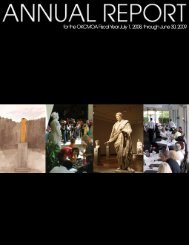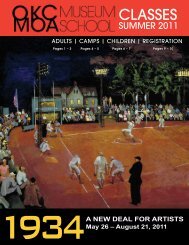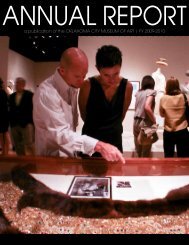Roman Art from the Louvre Educators' Resource Guide
Roman Art from the Louvre Educators' Resource Guide
Roman Art from the Louvre Educators' Resource Guide
You also want an ePaper? Increase the reach of your titles
YUMPU automatically turns print PDFs into web optimized ePapers that Google loves.
30<br />
Discussion Starters<br />
1. Describe this figurine. What position is<br />
<strong>the</strong> figure in? Where are his arms? What is<br />
he wearing? What do you think he is<br />
doing? If you could see his eyes, where do<br />
you think <strong>the</strong>y would be looking?<br />
2. What basic shapes do you see in this<br />
sculpture? Did <strong>the</strong> sculptor incorporate<br />
much detail? How big is <strong>the</strong> sculpture, and<br />
what do you think it is made out of? Do<br />
you think <strong>the</strong>re is a connection between<br />
<strong>the</strong> medium used and <strong>the</strong> amount of detail<br />
included? Do you think <strong>the</strong> use of a softer<br />
medium such as clay for <strong>the</strong> figure of <strong>the</strong><br />
gladiator would have affected <strong>the</strong><br />
appearance of <strong>the</strong> work? If so, how?<br />
3. How do you think <strong>the</strong> figurine was<br />
used? Do you think that this folding knife<br />
was a prized object used for special<br />
occasions or used everyday? Why do you<br />
think <strong>the</strong> artist chose to depict a Thracian<br />
gladiator on <strong>the</strong> handle of a knife? Can you<br />
think of any o<strong>the</strong>r imagery that would be<br />
appropriate for a knife handle?<br />
4. Have students research gladiators and<br />
discuss <strong>the</strong>m as a class. What do you<br />
think it would be like to be a gladiator?<br />
How do <strong>the</strong> helmets and o<strong>the</strong>r gear reflect<br />
<strong>the</strong> nationality of <strong>the</strong> gladiator? Is <strong>the</strong>re<br />
anything in <strong>the</strong> costume of <strong>the</strong> gladiator<br />
depicted in this piece that is particularly<br />
Thracian? How do you think you would feel<br />
watching a gladiator combat? What forms<br />
of modern entertainment resemble <strong>the</strong>se<br />
ancient combats? How are <strong>the</strong>y similar to<br />
or different <strong>from</strong> one ano<strong>the</strong>r?<br />
Activity: Leisure in Ancient<br />
Rome<br />
Materials: paper, pencils, colored markers<br />
Procedure:<br />
1. Ask students to research <strong>the</strong> different<br />
forms of entertainment and leisure<br />
activities in ancient Rome. Gladiator fights<br />
were very popular, as were chariot races,<br />
both of which took place in outdoor<br />
arenas.<br />
2. Have students work collaboratively to<br />
create a list of <strong>Roman</strong> leisure activities,<br />
noting when and where <strong>the</strong> activities took<br />
place and who participated in <strong>the</strong>m. For<br />
instance, men and women went to <strong>the</strong><br />
baths daily, after <strong>the</strong>ir work day was<br />
6. Knife Handle in <strong>the</strong> Shape of a Thracian Gladiator<br />
2nd half of 1st century A.D.<br />
Provenance unknown<br />
Bone<br />
H. 3K in.<br />
Musée du <strong>Louvre</strong>; Purchased in 1825, formerly in <strong>the</strong> Durand collection<br />
(s 2032)<br />
Designed as a handle for a folding knife, this bone figurine takes <strong>the</strong> form<br />
of a Thracian gladiator. “Thracian” refers to a particular category of gladiator<br />
named for <strong>the</strong> region of Thracia (nor<strong>the</strong>ast of Greece), which was conquered<br />
by Rome in 168 B.C. The Thracian prisoners of war were used as<br />
gladiator combatants in <strong>the</strong> arena and could be recognized by <strong>the</strong>ir heavy<br />
defensive armor and sharp daggers, which featured a curved blade known<br />
as a sica. This gladiator wears an impressive, broad-rimmed helmet, surmounted<br />
by a tall crest that is broken off at <strong>the</strong> top. The helmet is fastened<br />
in front with a pierced visor.<br />
The helmet makes it possible to date this statuette. After mid-century, <strong>the</strong><br />
rim of <strong>the</strong> Thracian gladiator helmet became expanded and <strong>the</strong> visor, formerly<br />
pierced by eyepieces, took <strong>the</strong> form of a grille that took up its entire<br />
upper portion. This visor was made up of numerous removable flaps. Fea<strong>the</strong>rs<br />
were attached to <strong>the</strong> notches located on both sides of <strong>the</strong> dome, and<br />
<strong>the</strong> helmet was surmounted by a tall crest ending in a griffon’s head. Here<br />
<strong>the</strong> griffon—a mythical animal favored by Nemesis, <strong>the</strong> goddess of fate, to<br />
whom gladiators prayed before combat—has been broken off.<br />
The shield is inscribed in Greek with <strong>the</strong> name Fundilanous, which may<br />
refer to <strong>the</strong> owner of <strong>the</strong> knife or even to a gladiator. Although not <strong>the</strong><br />
case here, many gladiators, like athletes today, chose colorful surnames to<br />
enhance <strong>the</strong>ir public identity. One gladiator whose name is preserved on a<br />
funerary monument was known as Antaios, <strong>the</strong> name of a giant <strong>from</strong> Greek<br />
mythology.<br />
Many similar knives sculpted in bone or ivory have been discovered in<br />
Italy and throughout <strong>the</strong> rest of <strong>the</strong> empire. The <strong>Roman</strong>s loved gladiatorial<br />
combat and frequently depicted it on utilitarian objects.
















